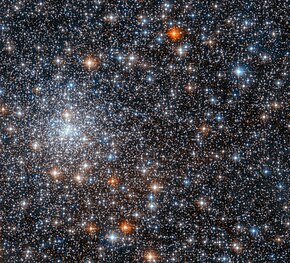| NGC 6558 | |
|---|---|
 The globular cluster NGC 6558 imaged by the Hubble Space Telescope The globular cluster NGC 6558 imaged by the Hubble Space Telescope | |
| Observation data (J2000 epoch) | |
| Class | V |
| Constellation | Sagittarius |
| Right ascension | 18 10 18.38 |
| Declination | −31° 45′ 48.6″ |
| Distance | 24.1 kly (7.4 kpc) |
| Apparent magnitude (V) | 11.29 |
| Physical characteristics | |
| Radius | 5.2' x 5.2' |
| Metallicity | = -1.32 dex |
| Other designations | Cr 368, GCl 89, ESO 456-62, VDBH 259 |
| See also: Globular cluster, List of globular clusters | |
NGC 6558 is a globular cluster, located about 24,000 light years away in the constellation Sagittarius. Its apparent magnitude is about 11 and its apparent diameter is about 10 arcminutes. The globular cluster was discovered in 1784 by the astronomer William Herschel with his 18.7-inch telescope and the discovery was later catalogued in the New General Catalogue.
It is located 1.5 degrees south-southeast of Gamma Sagittarii.
References
- ^ "NGC 6558". SIMBAD. Centre de données astronomiques de Strasbourg. Retrieved 8 January 2017.
- ^ "NGC 6558". Retrieved 8 January 2016.
- "A Galactic Globular Clusters Database: NGC 6558". Retrieved 8 January 2017.
- Souza, S. O.; Libralato, M.; Nardiello, D.; Kerber, L. O.; Ortolani, S.; Pérez-Villegas, A.; Oliveira, R. A. P.; Barbuy, B.; Bica, E.; Griggio, M.; Dias, B. (2024). "Combined Gemini-South and HST photometric analysis of the globular cluster NGC 6558. The age of the metal-poor population of the Galactic Bulge". arXiv:2407.15918 .
In the literature, the heliocentric distance of NGC 6558 ranges from ∼6.3 kpc (Rich et al. 1998) to ∼8.3 kpc (Barbuy et al. 2018b).
- Notes
- The central value in the range is 7.3 kiloparsecs (24,000 ly).
External links
This star cluster–related article is a stub. You can help Misplaced Pages by expanding it. |
 = -1.32
= -1.32